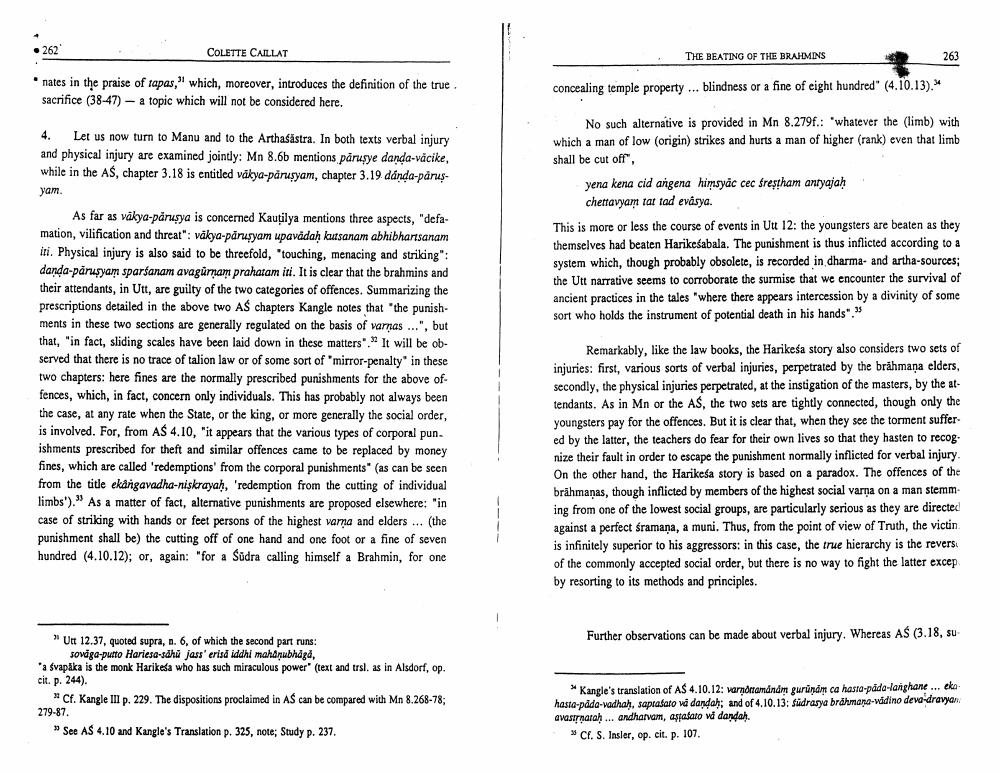________________
• 262
COLETTE CAILLAT
THE BEATING OF THE BRAHMINS
263
nates in the praise of tapas," which, moreover, introduces the definition of the true sacrifice (38-47) - a topic which will not be considered here.
concealing temple property ... blindness or a fine of eight hundred" (4.10.13).
4. Let us now turn to Manu and to the Arthaśāstra. In both texts verbal injury and physical injury are examined jointly: Mn 8.6b mentions parusye danda-vácike, while in the As, chapter 3.18 is entitled vákya-părusyam, chapter 3.19 dánda-parus. уат.
No such alternative is provided in Mn 8.279f.: 'whatever the (limb) with which a man of low (origin) strikes and hurts a man of higher (rank) even that limb shall be cut off",
yena kena cid angena himsyac cec frestham antyajah
chettayam tat tad eväsya. This is more or less the course of events in Uu 12: the youngsters are beaten as they themselves had beaten Harikesabala. The punishment is thus inflicted according to a system which, though probably obsolete, is recorded in dharma and artha-sources; the Utt narrative seems to corroborate the surmise that we encounter the survival of ancient practices in the tales "where there appears intercession by a divinity of some sort who holds the instrument of potential death in his hands".
As far as vākya-panusya is concerned Kautilya mentions three aspects, "defamation, vilification and threat": väkya-panusyam upavadah kutsanam abhibhartsanam iti. Physical injury is also said to be threefold, "touching, menacing and striking": danda-parusya sparsanam avagúrnam prahatam iti. It is clear that the brahmins and their attendants, in Utt, are guilty of the two categories of offences. Summarizing the prescriptions detailed in the above two AS chapters Kangle notes that the punishments in these two sections are generally regulated on the basis of varnas ...", but that, 'in fact, sliding scales have been laid down in these matters. It will be observed that there is no trace of talion law or of some sort of 'mirror-penalty in these two chapters: here fines are the normally prescribed punishments for the above of fences, which, in fact, concern only individuals. This has probably not always been the case, at any rate when the State, or the king, or more generally the social order, is involved. For, from AS 4.10, "it appears that the various types of corporal pun. ishments prescribed for theft and similar offences came to be replaced by money fines, which are called 'redemptions' from the corporal punishments (as can be seen from the title ekangavadha-niskrayaḥ, 'redemption from the cutting of individual limbs)." As a matter of fact, alternative punishments are proposed elsewhere: "in
se of striking with hands or feet persons of the highest varna and elders ... (the punishment shall be the cutting off of one hand and one foot or a fine of seven hundred (4.10.12); or, again: "for a Södra calling himself a Brahmin, for one
Remarkably, like the law books, the Harikesa story also considers two sets of injuries: first, various sorts of verbal injuries, perpetrated by the brahmana elders, secondly, the physical injuries perpetrated, at the instigation of the masters, by the at tendants. As in Mn or the AS, the two sets are tightly connected, though only the youngsters pay for the offences. But it is clear that, when they see the torment suffer ed by the latter, the teachers do fear for their own lives so that they hasten to recog. nize their fault in order to escape the punishment normally inflicted for verbal injury. On the other hand, the Harikeša story is based on a paradox. The offences of the brahmaņas, though inflicted by members of the highest social varna on a man stemm ing from one of the lowest social groups, are particularly serious as they are directed against a perfect framana, a muni. Thus, from the point of view of Truth, the victin is infinitely superior to his aggressors: in this case, the true hierarchy is the revers of the commonly accepted social order, but there is no way to fight the latter excep by resorting to its methods and principles.
Further observations can be made about verbal injury. Whereas AS (3.18, su
Un 12.37, quoted supra, n. 6, of which the second part runs:
sovoga putto Harlesa-sdh jass' erisd iddhi mahanubhagd, a svapika is the monk Harikesa who has such miraculous power' (text and trslas in Alsdorf, op. cit. p. 244).
Cf. Kangle III p. 229. The dispositions proclaimed in AS can be compared with Mn 8.268-78; 279-87.
» See AS 4.10 and Kangle's Translation p. 325, note; Study p. 237.
* Kangle's translation of A$ 4.10.12: varnonamenom gurūnam ca hasta-pada-langhane...eko hasto.pdda-vadhah, saprafato vi dandah; and of 4.10.13: Sudrasya brahmana-waidino devo-dravyan avastrarah... andharvam, asfafato wa dandah.
CF. S. Insler, op. cit. p. 107.




